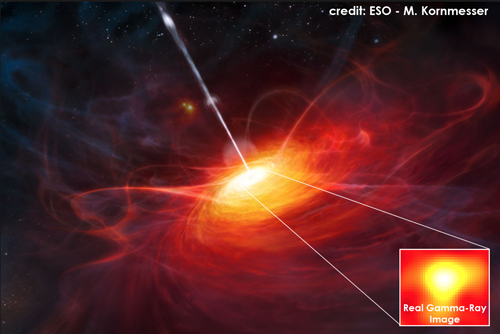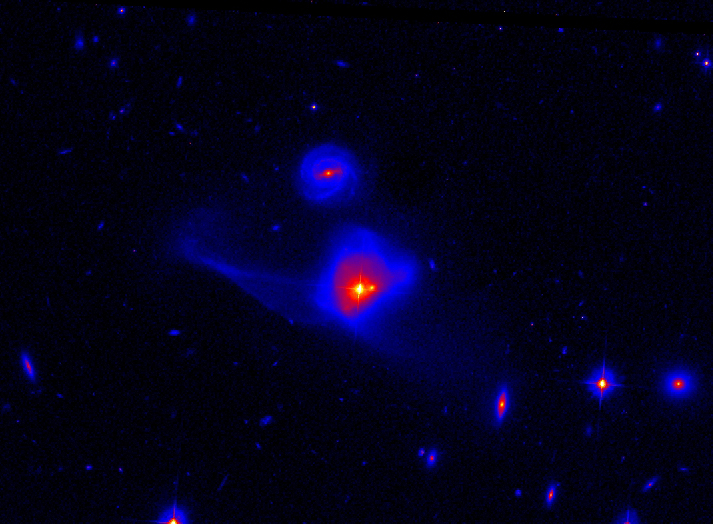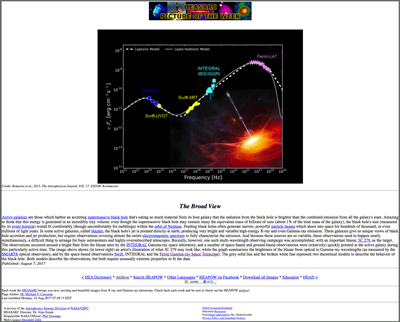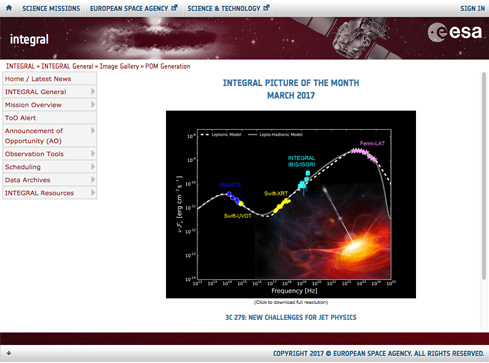
Single AGN
Single AGN are excellent case studies in order to address the mechanism that powers supermassive black holes. In the following are some results from my research.
Measuring the Spin of the Supermassive Black Hole in the galaxy Mrk 876
The immense gravity in the vicinity of supermassive black holes can distort and
twist space-time as an effect of General Relativity. While traveling through space-time
light gets distorted as. By measuring the distortion of X-rays streaming off the
material close to the black hole (accretion disk), it is possible to gain information
about its spin. The image shows a rendering of a black hole and the distorted light
streaming off the accretion disk.

In greater detail, another consequence of Einstein's relativity theory is that the faster a black hole spins, the closer the accretion disk can reach to the black hole. Therefore, the X-ray radiation streaming off the accretion disk around spinning black holes is strongly distorted. It is possible to assess how close the accretion disk can reach to the black hole (and thus its spin) by breaking the X-ray light up into different energies forming a spectrum. From the spectrum we measure in detail the distortion of the X-ray light arising from the single chemical elements of the accretion disk. Very specifically, the iron line is the most abundant element found on accretion disks. Therefore, its distortion (shape and energy position) allow to infer how close the accretion disk reaches to the black hole and thus the spin of it. Such a measurement has been performed with NASA's NUSTAR mission that observed Mrk 876, which is an active galactic nulceus. A detailed description can be found HERE.
NASA's Picture of the Week
NASA's High-Energy Astrophysics Science Archive Research Center shows our Broad View of a blazar jet on its webpages.
Click here!
ESA's Picture of the Month
The ESA celebrates our work with the INTEGRAL Picture of the Month on its webpages.
Goto ESA webpage!
3C 279: The Brightest Gamma-Ray Flare Ever Bringing the Jet Content to Light
The artist's rendering in the image below displays
the supermassive black hole in the center of an AGN.
When the jet arising from the center points at us, we see
an object called blazar. A real gamma-ray image of
such a blazar (and more precisely of the object called
3C 279) is shown in the lower right corner.

3C 279 is known to exhibit bright outbursts. We were able to capture its brightest outburst ever displayed in gamma rays. During this event 3C 279 was observed quasi-simultaneously with ground-based telescopes (1-meter class telescopes on Cerro Tololo in Chile - SMARTS at infra-red and optical frequencies) and with spaceborne instruments (Swift, INTEGRAL, and Fermi missions at ultraviolet, X-ray and gamma-ray frequencies). The modeling of the so obtained broad-band spectrum allowed us to infer the jet content in 3C 279, which we find to be composed of hadrons in addition to leptons. The results of the modeling challenge the physical conditions in the jet. A detailed description can be found HERE.
Mrk 876: The Supermassive Black Hole is Rotating!
The image below displays Mrk 876 observed with
the Hubble Space Telescope: its irregurlare stucture,
the long tidal tails, and the 2 nuclei (the two
bright spots in the center of Mrk 876) point to the
fact the galaxy is the result of a recent merger
of 2 galaxies.

It is predicted that mergers host a rapidly rotating SMBH. However, its measurmente is not straightforward. We were able to measure with Swift-XRT an extreme redshifted and transient iron line. This lead us to constrain that the accretion disk in Mrk 876 extends below 6 gravitational radii, which is possible for rotating Supermassive Black Holes only. This finding confirms that the merger event for Mrk 876 has produced a rotating Supermassive Black Hole. A detailed description can be found HERE.
1ES 1959+650: First Clear Measurement of the Concave X-ray to Gamma-Ray Spectrum
1ES 1959+650 is one of the most remarkable
high-peaked BL Lacertae objects (HBL). Our multifrequency
campaign with INTEGRAL/IBIS, Swift/XRT, Swift/UVOT,
and Palomar 60 inch telescope allowed for a very precise
sampeling of the spectral energy distribution (SED; see
figure below).

We were able to measure the concave part of the SED where synchrotron and inverse-Compton emission components are competing. Both, SSC model and lepto-hadronic model are able to reproduce the SED. A detailed description can be found HERE.
PKS 0537-286: The High-Redshift Blazar Carrying Information on the Environment of the Early Universe
PKS 0537-286 is at redshift 3.1 and belongs to the
flat spectrum radio quasars. The source has been
observed by INTEGRAL/IBIS, Swift/BAT, Swift/XRT,
Swift/UVOT, XMM-Newton, RXTE, REM, and GROND. The
SED is shown here below.

The eye catching feature is that for frequencies between 14 < log(ν) < 15, the SED (solid line) does not represent the data well. This is due to the Ly-α drop. This method allows us to estimate the distance of the object in an independent approach. The method has been extensively applied to estimate the redshift of FERMI-LAT blazars that do not display line features for which it would be diffucult or even impossible to find the redshift. For reference see HERE. A detailed description of the multifrequency compaign on PKS 0537-286 can be found HERE.

